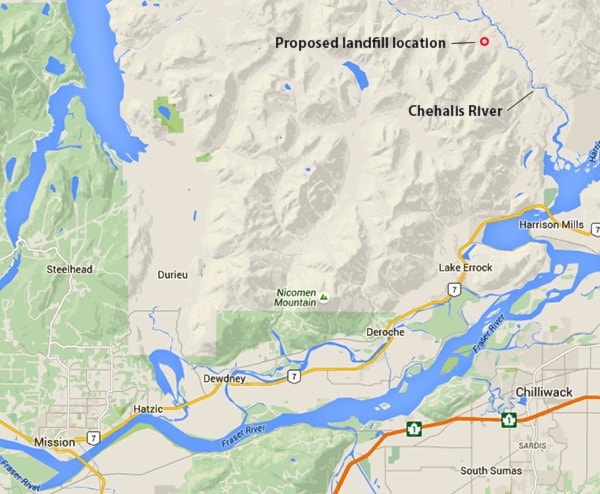The Fraser Valley Regional District (FVRD) board is expected to vote in February on whether to give the go-ahead to a proposed landfill for contaminated soil in the Chehalis River Valley.
Statlu Resources has proposed to extract gravel from a site 10 kilometres up the Chehalis Forest Service Road and back-fill it with remediated soil sourced from contaminated sites like gas stations, car repair shops and dry cleaners.
Around 80 people attended a public meeting in December, with most voicing opposition to the proposal, which would be located about half a kilometre from the Chehalis River.
Statlu’s proposal calls for between 350 to 1,000 tonnes of soil to be dumped at the site each work day. In a technical assessment commissioned by the company and delivered prior to the meeting, a consulting firm reported that the soil could contain “residual petroleum hydrocarbons, chlorinated hydrocarbons, and heavy metals.”
But Statlu president Earl Wilder stressed that the material is “not a hazardous waste,” and presently dumped elsewhere in the Lower Mainland with less care than his plan envisions.
Statlu’s technical assessment envisions a double-bottom lined fill site, with a wastewater purification system to treat effluent.
“Due to the distance between the effluent discharge point and the Chehalis River and that the minimum daily flow in Chehalis River is more than 1,000,000 times of the effluent flow, we consider it to be a low potential that the discharge of treated water will have a significant impact on the Chehalis River,” the technical report states.
Wilder said the chances of a spill were one in 400 million – more than 10 times less likely than a lottery win. Having trucks transporting materially both to and from the site aims to improve the economic feasibility of the site, and Wilder said the project would create jobs and other economic benefits for the region.
Downstream, though, there is concern about the proposal. One resident expressed worries that any problems at any soil landfill up the valley would impact the river and the drinking water of those down river.
“I can see the creek from my house and it feeds the water supply for the whole subdivision down here,” he said. “It’s something of a concern to everybody down here.”
In its November report, FVRD staff said there were both benefits and drawbacks to the plan, which follows several others from Statlu, including a now-abandoned proposal that would have seen automobile residue disposed of at the site.
Planner David Bennett wrote that the remoteness of the site would reduce conflicts with residents, although truck traffic would still be seen. But he added that “the Chehalis River Valley is viewed as a wilderness area that supports resource extraction, tourism, recreation and ecological functions. A landfill is not consistent with this view.”
Area C director Alec Niemi said he hasn’t taken a position on the proposal, to allow others to make up their minds independently. He said, though, that the company has “a pretty good sales job on their hands” to convince local residents to back the project.
“They’re coming into a watershed; they’re coming into a rainforest.”
Wilder, though, said opposition to the plan is based on misinformation.
“The fuss is way out of control because of a lack of knowledge,” he said. “It’s the best site in the whole Lower Mainland that’s ever been discovered.”
The FVRD’s electoral area services committee will receive a report next week. Subsequent reports are expected in February prior to a vote on the necessary rezoning for the project.
